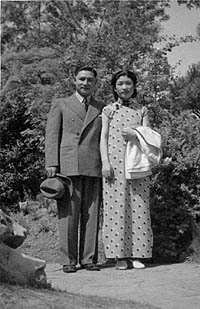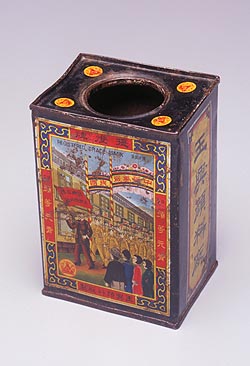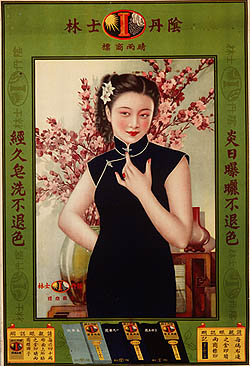|
Political,
economic and social change
The beginning of the 20th century saw much change in
China: political, economic, social and cultural. The
social changes gained impetus after the 1911 revolution
which resulted in the demise of the Qing dynasty. Social
reform led to change in dress codes too. The head shaving
and queue (long plait) men had been forced to
wear, to demonstrate their subservience, gradually disappeared.
The practice of foot
binding also decreased.

Sun
Yat-sen and his wife Song Qingling, Shanghai, 1922.
Sun Yat-sen wearing a jacket with a closed-stand
collar and centre-front opening known as Qiling
wenzhuang, which was popularly worn by Chinese students
in Japan and south-east Asia and inspired by the
Japanese student's uniform. Song Qinling wears a
jacket and skirt or aoqun. |
Dr
Sun Yat-sen (Sun Zhongshan) was instrumental
in the fall of the Qing (Ch'ing) Dynasty in 1911 and
was named Provisional President of the Republic. He
is popularly regarded as the father of modern
China. He is also credited with the development of a
form of national dress which embodied modern values
and the notion of equality. What came to be known as
the Sun Yat-sen suit developed over more than 50 years.
It was a complex mix of:
- Japanese
Meiji period (1868-1912) student uniform
- military
dress
- the
Western suit.
|

Sun
Yat-sen and his wife Song Qingling, Guangzhou,
1923. Sun Yat-sen wears a jacket with a turn-down
collar and four symmetrically placed pockets,
features which derive from Western military dress.
|
|

Black Sun Yat-sen jacket
(Zhongshan fu): this 1930s style, wool
Sun Yat-sen suit features pleats in the top pockets,
Western-style centre-back seam, waistband and
vent. Powerhouse Museum collection. 98/126/40
|
|

Note the similarities between the
Sun Yat-sen suit and the Western suit pictured.
Photo courtesy: Wang family. |
Activity
Sketch the Sun Yat-sen suit. Label the sketch with the
features from the Japanese student uniform, German military
dress and the Western suit.
For
a contemporary version of the Sun Yat-sen suit see Sun
Jian's trouser suit. Sun Jian is a fashion designer
from mainland China.
Emancipation
of women expressed through fashion
Life in China in the early 20th century was characterised
by great freedom of expression. Fashion was influenced
by women's emancipation and their pursuit of education,
employment and independence. Western fashions also influenced
dress, and styles changed rapidly, affected by the unstable
political climate.
While many fashion-conscious women dressed in a Western
manner, the majority chose between two forms of Chinese
dress - the jacket and skirt called aoqun which
had evolved from Han Chinese dress, and a one-piece
garment called the qipao or cheungsam.
During the early 20th century the aoqun became
shorter and more tailored in response to Western dress
and changes in fashion.
The
most distinctive women's garment to emerge during this
time was the qipao or cheungsam. This
was a one-piece garment, the design of which may be
traced back to Manchu dress of the Qing Dynasty. By
the 1930s, the qipao became the most fashionable
style of female dress. Influenced by Western fashion,
it revealed a woman's body unlike any previous Chinese
garment. The qipao and Sun Yat-sen suit thus
came to represent modernity in Chinese clothing.
Fabric
dyes
|
 Both local and imported dyes were
used for textiles made in China during the Republican
period. Dyes were made by a number of Chinese
and international companies including the well
known German dye company I. G. Farben. An illustration
on a dye tin in the collection of the Powerhouse
Museum depicts the Ruisheng Dye Company in Tianjin,
and a street parade promoting the Yuxing Dye Company.
The men, wearing Sun Yat-sen suits, are walking
through an archway which proclaims Long Live
the Republic. Powerhouse
Museum collection. 98/126/95
Both local and imported dyes were
used for textiles made in China during the Republican
period. Dyes were made by a number of Chinese
and international companies including the well
known German dye company I. G. Farben. An illustration
on a dye tin in the collection of the Powerhouse
Museum depicts the Ruisheng Dye Company in Tianjin,
and a street parade promoting the Yuxing Dye Company.
The men, wearing Sun Yat-sen suits, are walking
through an archway which proclaims Long Live
the Republic. Powerhouse
Museum collection. 98/126/95
|

Poster: This is one of
many posters which advertised Indantren fabric
dye. The young woman wears a sleeveless dark blue
cheungsam. Fabrics dyed with Indantren (from the
German dye company, Farben) were very popular
in the 1930s due to their colour-fastness and
durability.
The
company created a large range of colourful advertising
material including posters, display cards and
labels for fabric bolts. Powerhouse Museum collection.
95/29/12. This poster was used on the cover of
the Evolution and revolution catalogue.
|
|